
Mimosa is a genus of about 400 species of herbs and shrubs, in the mimosoid clade of the legume family Fabaceae. The generic name is derived from the Greek word μῖμος (mimos), an "actor" or "mime", and the feminine suffix -osa, "resembling", suggesting its 'sensitive leaves' which seem to 'mimic conscious life'.

Smilax is a genus of about 300–350 species, found in the tropics and subtropics worldwide. In China for example about 80 are found, while there are 20 in North America north of Mexico. They are climbing flowering plants, many of which are woody and/or thorny, in the monocotyledon family Smilacaceae, native throughout the tropical and subtropical regions of the world. Common names include catbriers, greenbriers, prickly-ivys and smilaxes. Sarsaparilla is a name used specifically for the Jamaican S. ornata as well as a catch-all term in particular for American species. Occasionally, the non-woody species such as the smooth herbaceous greenbrier are separated as genus Nemexia; they are commonly known by the rather ambiguous name carrion flowers.

Huperzia is a genus of lycophyte plants, sometimes known as the firmosses or fir clubmosses; the Flora of North America calls them gemma fir-mosses. This genus was originally included in the related genus Lycopodium, from which it differs in having undifferentiated sporangial leaves, and the sporangia not formed into apical cones. The common name firmoss, used for some of the north temperate species, refers to their superficial resemblance to branches of fir (Abies), a conifer. As of 2020, two very different circumscriptions of the genus were in use. In the Pteridophyte Phylogeny Group classification of 2016, Huperzia is one of three genera in the subfamily Huperzioideae of the family Lycopodiaceae. Most species in the subfamily are placed in the genus Phlegmariurus. Huperzia is left with about 25 species, although not all have been formally transferred to other genera. Other sources recognize only Huperzia, which then has about 340 species.

Dioscorea is a genus of over 600 species of flowering plants in the family Dioscoreaceae, native throughout the tropical and warm temperate regions of the world. The vast majority of the species are tropical, with only a few species extending into temperate climates. It is named by the monk Charles Plumier after the ancient Greek physician and botanist Dioscorides.

Theobroma is a genus of flowering plants in the mallow family, Malvaceae, that is sometimes classified as a member of Sterculiaceae. It contains roughly 20 species of small understory trees native to the tropical forests of Central and South America. The generic name is derived from the Greek words θεός (theos), meaning "god," and βρῶμα (broma), meaning "food". It translates to "food of the gods."

Iresine is a genus of flowering plants in the family Amaranthaceae. It contains 20 to 25 species, all of which are native to the American tropics. The generic name is derived from the Greek word εριος (erios), meaning "wooly", referring to the trichome-covered flowers. Bloodleaf is a common name for those species that have colored foliage, and these are often cultivated as ornamental plants. Some species are additives to versions of the hallucinogenic drink ayahuasca.
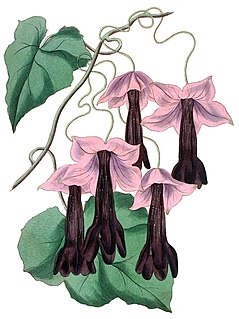
Rhodochiton is a genus of flowering plants within the family Plantaginaceae, native to southern Mexico and neighbouring Guatemala. They climb by means of twining leaf stalks. One of the three species, Rhodochiton atrosanguineus, the purple bell vine, is grown as an ornamental plant. All three species are sometimes included in Lophospermum.

Lophospermum is a genus of herbaceous perennial climbers or scramblers, native to mountainous regions of Mexico and Guatemala. Those that climb use twining leaf stalks. Their flowers are tubular, in shades of red, violet and purple, the larger flowers being pollinated by hummingbirds. Now placed in the greatly expanded family Plantaginaceae, the genus was traditionally placed in the Scrophulariaceae. The close relationship with some other genera, particularly Maurandya and Rhodochiton, has led to confusion over the names of some species.
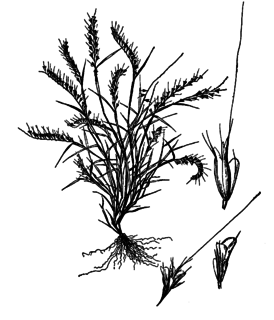
Aegopogon is a genus of New World plants in the grass family.
Elionurus is a genus of Asian, African, Australian, and Neotropical plants in the grass family.
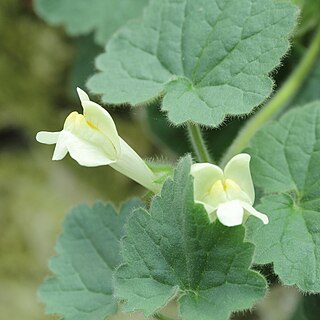
Asarina is a flowering plant genus of only one species, Asarina procumbens, the trailing snapdragon, which is native to southern Europe. Originally placed in the Scrophulariaceae, the genus has more recently been moved to the Plantaginaceae. Species from North America formerly placed in the genus Asarina are now placed in Holmgrenanthe, Lophospermum, Mabrya and Maurandya, as well as Neogaerrhinum. Asarina is now regarded as exclusively an Old World genus.

Maurandya is a genus of flowering plants in the family Plantaginaceae, native to Mexico and the south west United States. They sprawl or climb by means of twining leaf stalks. One of the four species, Maurandya barclayana, is widely cultivated as an ornamental plant.

Guettardeae is a tribe of flowering plants in the family Rubiaceae and contains about 748 species in 14 genera. Its representatives are widespread geographically and are found in the tropics and subtropics.
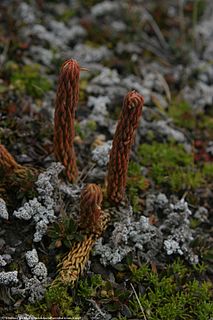
Phlegmariurus crassus is a lycophyte found in Central and South America.
Roving sailor most commonly refers to:

Holmgrenanthe petrophila is a rare perennial desert plant in the plantain family (Plantaginaceae), and the sole species of the genus Holmgrenanthe. It forms low mats of branched stems growing from a woody base. The leaves have small spines along their edges. The solitary yellow flowers are tubular with five free lobes at the end, the upper two pointing backwards, the lower three projecting forwards. The species is known only from about ten locations, most in the Titus Canyon and the adjacent Fall Canyon, all within the Californian section of Death Valley National Park. It grows in limestone crevices on the canyon walls, often on the north face.

Mabrya is a genus of flowering plants in the plantain family, Plantaginaceae. It consists of herbaceous perennials with brittle upright or drooping stems, found in dry areas of Mexico and the southern United States.

The Antirrhineae are one of the 12 tribes of the family Plantaginaceae. It contains the toadflax relatives, such as snapdragons. They are probably most closely related to the turtlehead tribe (Cheloneae) and/or a large and badly resolved core group of their family including plants as diverse as water-starworts (Callitriche), foxgloves (Digitalis), and speedwell (Veronica). The Antirrhineae include about 30 genera with roughly 320 species, of which 150 are in genus Linaria. The type genus is AntirrhinumL.
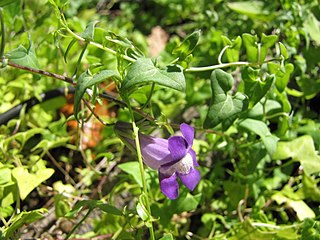
Maurandya antirrhiniflora, known as roving sailor or climbing snapdragon, is a scrambling or climbing herbaceous perennial native to Mexico and the south western United States where it grows in a variety of relatively dry habitats. It has more-or-less triangular untoothed leaves and tubular flowers in various shades of pink, red or blue to violet with white bases. Unlike other species in the genus Maurandya, the flowers have closed "lips"; it has sometimes been put into a separate genus as Maurandella antirrhiniflora.

Polybotryoideae is a subfamily of the fern family Dryopteridaceae.


















